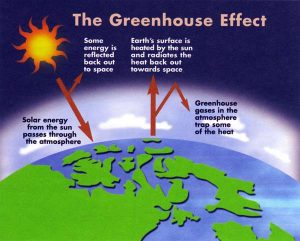The Greenhouse Effect
The greenhouse effect is a natural phenomenon that insulates the Earth . Incoming solar radiations are absorbed and reemitted back from the Earth’s surface as infrared energy, greenhouse gases (GHGs) in the atmosphere prevent some of this heat from escaping into space, instead reflecting the energy back to further warm the surface. Human activities that produce GHGs (anthropogenic) amplify the greenhouse effect. Anthropogenic GHG emissions are modifying the Earth’s energy balance between incoming solar radiation and the heat released back into space, resulting in climate change. Gases such as CO2 , NO2 , CFCs (chloro fluorocarbons) allow sun rays to pass through them but then absorb and reradiate the heat back towards the earth. These are therefore termed as green house gases.
The amount of solar energy absorbed or radiated by Earth is modulated by the atmosphere and depends on its composition. Greenhouse gases—such as water vapor, carbon dioxide, and methane—occur naturally in small amounts and absorb and release heat energy more efficiently than abundant atmospheric gases like nitrogen and oxygen. Small increases in carbon dioxide concentration have a large effect on the climate system.
Mazor Green House gases are:-
Carbon Dioxide (CO2)- 0.038%
Water Vapor (H20) -0-4%
Methane (CH4) -trace amount
Sulfur dioxide (SO2) -trace amount
Ozone (O3) -trace amount
Nitrogen oxides(NO, NO2, N2O)- trace amount
Mitigation is achieved by reducing both the energy intensity of GDP and the carbon intensity of energy used.Mazor Mitigation strategies are:-
- Improved supply and distribution efficiency; fuel switching from coal to gas; nuclear power; renewable heat and power (hydropower, solar, wind, geothermal and bioenergy); combined heat and power; early applications of carbon dioxide capture and storage (CCS) (e.g. storage of removed CO2from natural gas); CCS for gas, biomass and coal-fired electricity generating facilities; advanced nuclear power; advanced renewable energy, including tidal and wave energy, concentrating solar, and solar photovoltaics
- More fuel-efficient vehicles; hybrid vehicles; cleaner diesel vehicles; biofuels; modal shifts from road transport to rail and public transport systems; non-motorised transport (cycling, walking); land-use and transport planning; second generation biofuels; higher efficiency aircraft; advanced electric and hybrid vehicles with more powerful and reliable batteries
- Efficient lighting and daylighting; more efficient electrical appliances and heating and cooling devices; improved cook stoves, improved insulation; passive and active solar design for heating and cooling; alternative refrigeration fluids, recovery and recycling of fluorinated gases; integrated design of commercial buildings including technologies, such as intelligent meters that provide feedback and control; solar photovoltaics integrated in buildings
- More efficient end-use electrical equipment; heat and power recovery; material recycling and substitution; control of non-CO2 gas emissions; and a wide array of process-specific technologies; advanced energy efficiency; CCS for cement, ammonia, and iron manufacture; inert electrodes for aluminium manufacture
- Improved crop and grazing land management to increase soil carbon storage; restoration of cultivated peaty soils and degraded lands; improved rice cultivation techniques and livestock and manure management to reduce CH4 emissions; improved nitrogen fertiliser application techniques to reduce N2O emissions; dedicated energy crops to replace fossil fuel use; improved energy efficiency; improvements of crop yields
- Afforestation; reforestation; forest management; reduced deforestation; harvested wood product management; use of forestry products for bioenergy to replace fossil fuel use; tree species improvement to increase biomass productivity and carbon sequestration; improved remote sensing technologies for analysis of vegetation/soil carbon sequestration potential and mapping land-use change
- Landfill CH4 recovery; waste incineration with energy recovery; composting of organic waste; controlled wastewater treatment; recycling and waste minimisation; biocovers and biofilters to optimise CH4 oxidation
